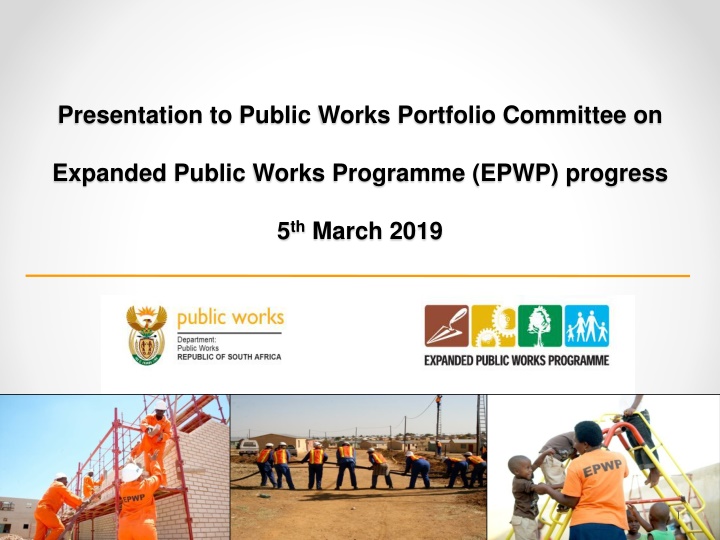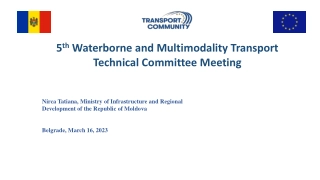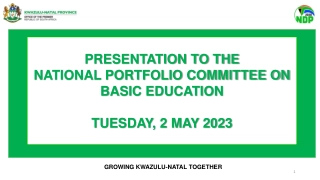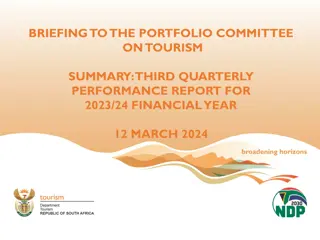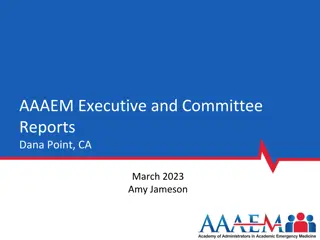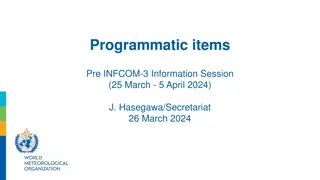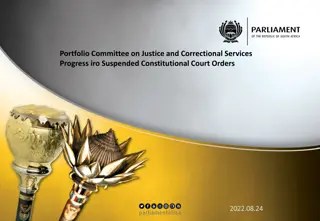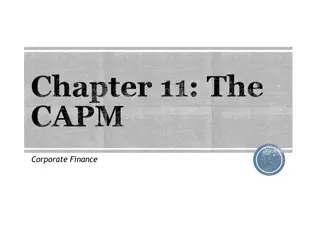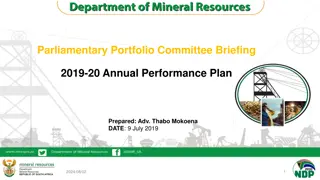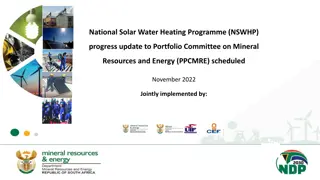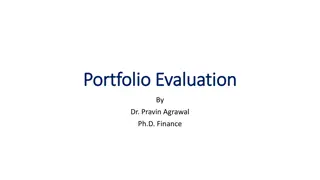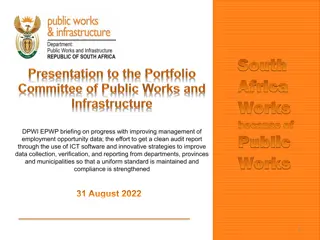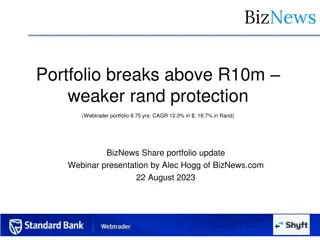Progress Report on Expanded Public Works Programme (EPWP) Presented to Public Works Portfolio Committee - 5th March 2019
The presentation to the Public Works Portfolio Committee outlined the progress, targets, and performance review of EPWP Phase III, strategic focus for Phase IV, expansion and improvement strategies, coordination, and institutional arrangements. It highlighted performance against annual and 5-year targets, showcasing a 73.2% achievement to date. Sector-wise performance, provincial sphere achievements, and work opportunities reported are also discussed.
Download Presentation

Please find below an Image/Link to download the presentation.
The content on the website is provided AS IS for your information and personal use only. It may not be sold, licensed, or shared on other websites without obtaining consent from the author.If you encounter any issues during the download, it is possible that the publisher has removed the file from their server.
You are allowed to download the files provided on this website for personal or commercial use, subject to the condition that they are used lawfully. All files are the property of their respective owners.
The content on the website is provided AS IS for your information and personal use only. It may not be sold, licensed, or shared on other websites without obtaining consent from the author.
E N D
Presentation Transcript
Presentation to Public Works Portfolio Committee on Expanded Public Works Programme (EPWP) progress 5thMarch 2019 1
Presentation Outline EPWP Phase III targets and Performance Review of the EPWP Phase III Strategic Focus for EPWP Phase IV Strategies for Expansion for EPWP Phase IV Strategies for Improvement for EPWP Phase IV Coordination and Institutional Arrangements in EPWP EPWP Phase IV Roadmap towards launch Recommendations 2
Performance against annual targets Performance against 5- Year Targets Phase 3: 5 Year shortfall of 1.6 m; 2018/19 deficit of 591 326 6,000,000 4,389,516 1,455,840 864,514 5-year Target 2018/2019 Target 106%66%58%64%59% Performance to date is at 73.2% against 5-year target. There is an increase of 0.4% as at the end of Q3 2018/19 Annual performance against target is at 59.4%. There is an increase of 1% since the close of Q3 2018/19 4
Performance against 5-year WO targets by sector The EPWP programme has reported 4 389 516 cumulative work opportunities to date since the inception of Phase 3. This is equivalent to 73.2% of the 6 million work opportunities target. Overall, the EPWP has a shortfall of 1 610 484 WOs to achieve the 5 year target. The least performing sectors are the Infrastructure Sector and the Non-State Sector s Community Work Programme, at 57.7% and 62.7% respectively. 1.3% 5
Provincial Sphere Performance against 5-year WO targets across all sectors Provincial Municipal Total WO Reported % Achieved Target WO Reported % Achieved Target WO Reported % Achieved Target 208 341 349 908 168% 293 845 119 994 41% 502 187 469 902 94% EC 128 532 95 690 74% 102 970 34 345 33% 231 502 130 035 56% FS 250 474 165 852 66% 373 289 181 825 49% 623 763 347 677 56% GP 524 552 497 154 95% 314 569 225 322 72% 839 121 722 476 86% KN 209 319 137 640 66% 175 407 94 358 54% 384 726 231 998 60% LP 146 661 118 192 81% 127 851 58 276 46% 274 512 176 468 64% MP 94 016 56 493 60% 40 194 24 276 60% 134 210 80 769 60% NC 151 652 97 899 65% 113 813 38 422 34% 265 465 136 321 51% NW 174 170 133 151 76% 228 816 186 418 81% 402 986 319 569 79% WC 1.3% 1 887 717 1 651 979 88% 1 770 755 963 236 54% 3 658 472 2 615 215 71% TOTAL 6
Provincial Sphere Performance against 5-year WO targets across all sectors 600,000 500,000 400,000 300,000 200,000 100,000 0 EC FS GP KN LP MP NC NW WC 1.3% 151,652 97,899 Target 208,341 128,532 250,474 524,552 209,319 146,661 94,016 174,170 WO Reported 349,908 95,690 165,852 497,154 137,640 118,192 56,493 133,151 7
Municipal Sphere Performance against 5-year WO targets across all sectors 400,000 350,000 300,000 250,000 200,000 150,000 100,000 50,000 0 EC FS GP KN LP MP NC NW WC Target 293,845 102,970 373,289 314,569 175,407 127,851 40,194 113,813 228,816 1.3% 38,422 34% WO Reported 119,994 34,345 181,825 225,322 94,358 58,276 24,276 186,418 % Achieved 41% 33% 49% 72% 54% 46% 60% 81% 8
Key Outputs of the EPWP programme The WO were achieved through the implementation of 69 891 projects across all provinces. Of the work opportunities created, 2 million were created for the youth, 2.9 million for women and 55 346 for people with disabilities. A total of R36 billion has been transferred to participants as wages, into poor communities. This income transferred not only reduces poverty but is also a form of economic stimulus, targeted directly at the poor. The increased focus on Community Works Programmes also allows this stimulus to address spatial inequality, target the poorest areas and strengthen productive activities in marginalised local economies; The assets and services provided includes 40 000 km of routine road maintenance carried out and 17 644 km of water reticulation installed. These assets can have transformative impacts on development through various sectors. 9
Q3 (Apr Dec) 2018/19 PERFORMANCE 10
EPWP Performance in terms of Work opportunities for the 18/19 financial year By the end of the 3rd quarter of the 18/19 financial year, 845,162 work opportunities have been reported against a target of 1, 455,840 which is 58% of the target. On the EPWP Reporting System in February 2019, the number of work opportunities reported was 864,514 which is 59% of the annual target. There is currently a big push with public bodies to ensure that there is optimal reporting for the 18/19 financial year. In terms of Full Time Equivalents, 250,481 Full Time Equivalents reported against a target of 591,846 for the 18/19 financial year. In February 2019, on the EPWP Reporting System, 265,017 Full Time Equivalents have been reported against a target of 591,8446 which is 45% of the target. The least performing sector is the EPWP Infrastructure Sector, mainly due to poor reporting by municipalities. 11
Sector Performance against annual work opportunity targets (2018/19) Annual WO Target 232 923 Q4 prelim WO Reported 155 223 244 968 228 430 Q3 WO Reported 149 170 237 365 224 959 62 945 170 723 845 162 % Sector Variance Achievement E&C Sector Infrastructure Sector589 473 CWP NPOs Social Sector Total 6 053 7 603 3 471 421 1 804 19 352 67% 42% 63% 111% 80% 59% 362 000 57 000 214 444 1 455 840 63 366 172 527 864 514 Q4 prelim FTEs Reported 45 728 64 098 48 633 23 994 82 563 265 017 Annual FTE Target Q3 FTEs Reported % Sector Variance Achievement E&C Sector Infrastructure Sector191 975 CWP NPOs Social Sector Total 94 301 42 922 58 807 48 005 22 435 78 312 250 481 2 807 5 291 628 1 559 4 251 14 536 48% 33% 31% 76% 71% 45% 157 391 31 602 116 577 591 846 1% 42% 69% 12
Work Opportunity performance across provinces considering provincial departments and municipalities after the 3rd quarter of the 18/19 financial year Provincial Departments have achieved 82% of their Work Opportunity target for the 18/19 financial year considering reporting at the end of the 3rd quarter of the 18/19 financial year. In terms of provincial departments, the Eastern cape has already achieved its work opportunity targets. In terms of municipalities, 40% of the work opportunity targets have been achieved by the end of the 3rd quarter of the 18/19 financial year. Generally municipalities are performing worse than provincial departments. Eastern Cape, KwaZulu-Natal and Western Cape are on track to meet their annual targets considering 3rd quarter reporting for the 18/19 financial year. The least performing province in the 18/19 financial after the 3rd quarter is Gauteng. This is mainly due to the poor performance of Metropolitan Municipalities in Gauteng. 13
Work Opportunity performance across provinces considering provincial departments and municipalities after the 3rd quarter of the 18/19 financial year in terms of Work Opportunities (WO) reported. Prov Mun Total Target WO Reported % Achieved Target WO Reported % Achieved Target WO Reported % Achieved 43 183 74 813 173% 72 417 24 992 35% 115 600 99 805 86% EC 27 280 20 380 75% 24 294 4 021 17% 51 574 24 401 47% FS 51 605 31 721 61% 87 323 22 186 25% 138 928 53 907 39% GP 112 632 99 532 88% 78 791 44 403 56% 191 422 143 935 75% KN 43 429 27 723 64% 46 336 16 891 36% 89 765 44 614 50% LP 31 344 18 569 59% 31 902 10 059 32% 63 246 28 628 45% MP 19 703 12 011 61% 9 612 4 264 44% 29 314 16 275 56% NC 31 922 18 443 58% 28 525 6 896 24% 60 447 25 339 42% NW 36 209 24 050 66% 48 967 39 582 81% 85 176 63 632 75% WC Total 397 307 327 242 82% 428 166 173 294 40% 825 473 500 536 61% 14
Training in the different provinces at the end of the 18/19 financial year Considering the work opportunities reported at the end of the 3rd quarter of the 18/19 financial, 42,761 work opportunities had training out of the 845,162 work opportunities reported. The training conducted was both accredited and non-accredited. The training reported was across the different sectors of the EPWP. There is a need for public bodies to conduct more training of participants on projects. Public bodies are being advised to set a side some of their project budget funds for training. 15
Training across the different provinces up to the 3rd quarter of the 18/19 financial year Overall distribution of work opportunities with training and without training per province 16
EPWP Integrated Grant to Provinces progress As at 18th of February 2019, 95% of the allocation had been transferred to eligible departments. Expenditure is 67% of the allocation at the 18th February 2019. Free State province has the highest expenditure at 85%. Eastern Cape has the lowest expenditure at 34%. 17
EPWP Integrated to Provinces progress for 18/19 financial year as of 18th February 2019 Expenditure as % transferred amount Allocation (R'000) Transferred to date (R'000) Transfers as % allocation Expenditure to date (R'000) Expenditure as % allocation Provinces Eastern Cape 90 077 87 658 97% 30 177 34% 34% Free State 27 378 24 415 89% 23 159 85% 95% Gauteng 46 758 42 547 91% 34 373 74% 81% KwaZulu-Natal 124 565 123 065 99% 93 876 75% 76% Limpopo 25 864 24 364 94% 20 628 80% 85% Mpumalanga 32 816 26 995 82% 25 874 79% 96% Northern Cape 21 769 19 589 90% 14 348 66% 73% North West 17 673 17 673 100% 14 527 82% 82% Western Cape 29 136 29 136 100% 22 068 76% 76% Grant Total 416 036 395 442 95% 279 030 67% 71% 18
EPWP Integrated Grant to Municipalities progress As at the end of January 2019, 96% of the allocation had been transferred to eligible departments. Expenditure is 68% of the allocation at the end of January 2019. KwaZulu-Natal province has the highest expenditure at 78%. Limpopo has the lowest expenditure at 50%. 19
EPWP Integrated Grant to Municipalities progress at end of January 2019 for the 18/19 financial year Transfers as % allocation Expenditure Expenditure Allocated (R'000) Transferred to date (R'000) Expenditure to date (R'000) Summary by province as % as % allocation transferred Eastern Cape 98 566 92 189 94% 55 338 56% 60% Free State 24 453 23 379 96% 16 936 69% 72% Gauteng 106 794 105 459 99% 80 146 75% 76% KwaZulu Natal 204 011 201 762 99% 160 144 78% 79% Limpopo 52 587 46 085 88% 26 359 50% 57% Mpumalanga 60 311 58 991 98% 42 405 70% 72% Northern Cape 28 908 26 349 91% 18 533 64% 70% North West 36 536 34 988 96% 24 554 67% 70% Western Cape 80 712 78 324 97% 45 978 57% 59% Grant Total 692 878 667 526 96% 470 393 68% 70% 20
EPWP Social Sector grant progress As at the end of January 2019, 99% of the allocation had been transferred to eligible departments. Expenditure is 71% of the allocation at the end of January 2019. Free State province has the highest expenditure at 78%. Limpopo has the lowest expenditure at 50%. . 21
SOCIAL SECTOR GRANT FOR DEPARTMENTS as at end of Jan 2019 Expendit ure as % transferr ed amount Transfers as % allocati on Transferred to date (R'000) Expenditure to date (R'000) Expenditure as % allocation Provinces Allocation (R'000) Eastern Cape 30 831 30 395 99% 18 707 61% 62% Free State 52 518 52 518 100% 40 505 77% 77% Gauteng 14 241 13 144 92% 8 474 60% 64% KwaZulu-Natal 76 409 76 409 100% 56 873 74% 74% Limpopo 49 392 49 392 100% 36 612 74% 74% Mpumalanga 56 241 56 241 100% 38 817 69% 69% Northern Cape 35 657 35 657 100% 18 473 52% 52% North West 44 812 44 080 98% 33 508 75% 76% Western Cape 47 847 47 847 100% 35 840 75% 75% Grant Total 407 948 405 683 99% 287 809 71% 71% 22
Review of the EPWP Phase III A review of the EPWP Phase III was conducted by the technical support that was provided by a team of specialists from ILO to the DPW. The aim of the review was to identify the achievements, challenges and lessons learnt in the implementation of the EPWP Phase III. The methodology used in conducting the review was: extensive consultations with EPWP managers across all spheres of government and sectors of the programme, in-depth interviews with stakeholders, existing EPWP reports and analysis of available EPWP data. The findings from the review assisted to inform some of the proposals for EPWP Phase IV. An extensive Impact Evaluation of the EPWP Phase III is currently underway to be completed in June 2019. 24
Key Findings of the EPWP Phase III Review Thematic Area of review Key Findings and recommendations Targets were unrealistic and that many public bodies did not have the capacity to implement and report EPWP projects and that the targets should also be linked to MTEF allocations made to public bodies and adjusted where budgets are reduced. 1. Targets and target setting There is limited commitment for using own funding for implementation of the programme due to lack of legislation. There is a need for the programme to look outside the fiscus for additional funding and develop a policy to enforce implementation. 2. Funding and incentive grants There is insufficient technical and managerial capacity for EPWP implementation among many implementing public bodies officials. While the PEP-IMC has raised the profile of the EPWP in particular among political leadership, it was found that this structure could have an even more impactful role on the EPWP. Institutional arrangements and coordination 3. Implementation of the EPWP Universal principles Compliance with the EPWP principles has improved on EPWP reported projects. Strengthening the monitoring of the core EPWP principles to improve compliance to the EPWP guidelines. 4. Given the large number of EPWP participants, providing all them with training was found not to be feasible due to the limited budget/funding. Partnerships with private sector should be strengthened for investments, placements and training. Training and enterprise development 5. Even though EPWP is a public sector programme, the review recommended that EPWP should identify opportunities for increased involvement or partnerships with the private sector. Involvement of the private sector Secret 25 7. 25
Process for Development of EPWP Phase IV To review the EPWP Phase III and to develop the EPWP Phase IV proposal, the following departments and parties have been consulted: National Treasury, Environmental Affairs, Social Development, Transport, Tourism, Cooperative Governance, Human Settlements, Health, Agriculture, Forestry and Fisheries, Arts and Culture, Minerals, Energy, Basic Education, Higher Education, Labour, Presidency as well as all Provincial Departments of Public Works and other relevant Provincial departments, all Metropolitan Municipalities and a large number of District and Local Municipalities. The Cabinet Committee for the Economic Sectors, Employment and Infrastructure Development (ESEID) Cabinet Committee in its meeting of 28 November 2018 approved the Expanded Public Works Programme (EPWP) Phase IV proposal (with comments) for implementation from 01 April 2019 to 31 March 2024. The proposal subsequently served at the Cabinet Meeting of 05 December 2018 that provided additional comments. These comments have subsequently been included in the reworked proposal. Based on the inputs received, the Department of Public Works (DPW), together with other lead and implementing departments, developed a revised proposal for roll-out and implementation. 27
ESEID Cluster Recommendations There should be an expansion of the scope of the EPWP There should be a vigorous assessment of EPWP Phase 3 to consider the lessons learned and prepare for future planning Private sector engagements should be pursued in a much stronger way. The PEP-IMC must meet regularly to ensure a continuous focus to advance PEPs. There should be sustained efforts to source additional investment in PEPs. 28
ESEID Cluster Recommendations ( cont.) Safety Programmes have to be explored to ensure safety of tourists in order to boost tourism in the country. The EPWP must explore road alternative road paving methodologies (methods and materials) to ensure greater efficiencies. TVET and Community Colleges should be used for artisan development among the youth to advance maintenance work (and thus create work opportunities for young people) as a particular focus area for PEPs. The original intent of the EPWP as a skills development programme should not be lost. DPME should develop a brand for the EPWP/PEPs with a particular youth focus to inspire patriotism and develop a responsible citizenry. 29
The Objective of the EPWP Phase IV The Objective of EPWP Phase IV is: To provide work opportunities and income support to poor and unemployed people through the delivery of public and community assets and services, thereby contributing to development Poor unemployed people will improve their well-being through: 1. Acquiring work based skills and workplace experience enhancing their potential to find further work in the formal or informal sector. Employment Creation Programme Impact 2. Earning an increased income and improving their household security Income Support Development of community assets and the provision of services 3. Benefiting from improved service delivery and infrastructure in their communities. 30
EPWP Phase IV Focus Areas Strengthening the monitoring of the core EPWP principles to improve compliance to the EPWP guidelines. Expansion of the programme through replication and improved in programmes across all sectors. Enhancing the EPWP coordination and institutional arrangements including the PEP-IMC. Strengthening impact evaluation of the EPWP and ensure greater transparency and introduction of Social Audits. accountability through the Strengthening partnerships with the private sector and TVET Colleges. 31
EPWP Phase 4 targets EPWP phase 4 will target the reporting of at least 5 million work opportunities across the different sectors of the EPWP. The EPWP Infrastructure Sector is expected to contribute the highest number of work opportunities followed by the Community Work Programme component of the Non-State Sector. 33
Confirmed WO Targets per sector Environment and Culture Year Infrastructure Social Non-State 2019-2020 320,311 181,458 182,947 307 076 991,792 2020-2021 330,075 185,838 184,820 293 376 994,110 2021-2022 339,068 189.838 185,277 305 017 1,018,950 2022-2023 347,720 193,260 186,042 305 016 1,032,039 2023-2024 357,349 197,103 187,074 305 016 1,046,543 TOTAL 1,694,524 947,247 926,160 1 515 501 5,083,433 34
Demographic Targeting in the EPWP Phase IV Targeting of vulnerable groups Category EPWP Phase IV Women 60% Target Youth between 16 and 35 55% Persons with disabilities 2% Self-Targeting Through the EPWP Minimum wage rate Targeting Methods 35 35
Phase IV Strategies for Improvement and Expansion 36
Expansion Areas in the EPWP Phase IV 1. The scope will be expanded through replication and improved in programmes such as Safety Programmes, Early Childhood Development, Chefs Programme to increase their coverage in terms of participating public bodies that will lead to increased job creation. 2. Tourism safety programmes (tourist safety ambassadors, tourist guides ) will be replicated to other provinces in order to boost tourism in the country. 3. Engagements will relevant public bodies to expand road construction and maintenance programmes Youth Programmes, such as the National Youth Service, Youth Environmental Service, Youth Ambassadors will be strengthened and expanded in the different sectors to increase youth participation The scope of EPWP to be expanded to include non-participating departments and new programmes to ensure mainstreaming of EPWP 37
EPWP Universal Principles All EPWP workers should be employed under EPWP conditions as stipulated in the EPWP Ministerial Determination as per recruitment guidelines All EPWP projects and programmes should recruit workers based on the EPWP recruitment guidelines. 1- Adherence to the conditions under the EPWP ministerial determination and payments of wage that is equal to or above the EPWP minimum wage or applicable sectoral minimum wage. 2- Selection of workers based on the EPWP recruitment guidelines 3- Work done in the EPWP provides or enhances goods community services 4- Minimum labour- intensity appropriate to sector or subsector public or The work output of each EPWP project programme contribute to enhancing public goods community services. or A minimum labour- intensity (LI) benchmark appropriate to each sector should be set. should or 38
Training & Enterprise Development Training interventions will aim to provide participants with skills required by the EPWP projects and/or skills that enhance participant livelihoods, which may include enterprise development interventions. The EPWP training unit will explore other opportunities in Government, linked to existing Government programmes to provide training toward sustainable livelihoods, inclusive of enterprise development. Identification of Public and Private Partnerships with TVETs, SETAs, Community Colleges and companies for placement and further training opportunities. Partnership with the private sector to identify skills required by the labour market that can be provided by Government. Sourcing of external funding that will be dedicated to expand sustainable programmes like Learnership Programmes and Artisan Development Programmes. Enterprise development partnerships will be expanded through sectors and provinces, with DPW providing the strategy for enterprise development. 39
EPWP Cross Cutting Implementation Strategies in Phase IV M&E Private Sector Funding 1. Strengthening the monitoring of the core EPWP principles to improve compliance to the EPWP guidelines. 2. Streamlining monitoring and reporting mechanisms to track programme performance. 3. Greater transparency and accountability will be achieved through the introduction of Social Audits. 4. More investments in evaluations and impact assessments. 1. Partnerships will be strengthened to attract investments, grow SMME s Ensure alignment of EPWP skills versus skills required by the private sector and Placement of EPWP participants with relevant private sector firms. 1. Additional investments to leverage the current funding used to implement the EPWP will be sourced through donor funding and partnerships which will be forged with the private sector. 2. 3. 40
Enhancing EPWP Coordination and Institutional Arrangements In EPWP Phase IV: The DPW will carry out its overall coordinating role and report on progress through the relevant clusters and the Inter-Ministerial Committee on Anti Poverty. Existing partnerships will be strengthened and new partnerships should be created to leverage resources and for implementation of projects. It is recommended that there should be dedicated personnel in Public Bodies responsible for EPWP to ensure implementation Protocol agreements will be signed between MEC s of Public Works with Local Municipalities and Provincial departments. Furthermore as a means of ensuring accountability by public bodies and it is proposed that as a matter of EPWP policy, Senior officials responsible for coordination and implementation of EPWP projects must have EPWP performance targets included in their performance agreements. The EPWP Co-ordination structures will be reviewed in EPWP Policy development process. Recommendations from the Policy development process will be implemented in year 2. 42
National, Sector and Provincial Coordination in EPWP Phase IV Department of Public Works Department of Environmental Affairs Department of Social Development Provincial Departments Municipalities The Department of Public Works will continue to coordinate, monitor and evaluate the EPWP programme and lead the Infrastructure and the Non-state sectors. The Department of Environmental Affairs will lead and coordinate the Environment and Culture Sector. The Department of Social Development will lead and coordinate the Social sector. At the provincial level, the provincial departments of Public Works will coordinate the municipalities and implementing departments in the province. Transitioning from the EPWP Phase III to Phase IV will not entail significant increases in personnel across the programme in general. The PEP IMC which has raised the profile of the EPWP in particular among political leadership should meet regularly and assist the programme by holding the executive accountable for implementing the EPWP. 43
EPWP Phase 4 Roll-out Plan Activity MINMEC of Lead Sector Department Phase 4 orientation: DPW EPWP Phase 4 orientation: National and Provincial stakeholders Objective To present the approved EPWP Phase 4 Plan. Date Feb 2019 To create awareness amongst DPW EPWP staff and equip them to be ambassadors for EPWP Phase 4 To create awareness amongst EPWP stakeholders and equip them to be ambassadors for EPWP Phase 4 Feb 2019 Feb 2019 Provincial road-shows building up towards the launch Projects and beneficiaries profiling Engage stakeholders, e.g. public bodies, communities, NGOs, business and beneficiaries on EPWP Phase 4 processes Communicate positive EPWP success stories and lessons learnt Mar 2019 February 2019 and beyond Media Campaigns Communicate EPWP Phase 4 to various target groups through relevant communication channels Engage and communicate EPWP Phase 4 to relevant stakeholders Disseminate the final signed off business plan with targets February 2019 and beyond April 2019 EPWP Phase 4 launch Phase 4 Business Plan dissemination March 2019 45
Recommendations It is recommended that the Public Works Portfolio Committee Notes the performance of the EPWP Phase III Notes the development processes for EPWP Phase IV Notes the EPWP Phase IV strategies and targets Supports the roll-out of EPWP Phase IV 46
I THANK YOU 47
